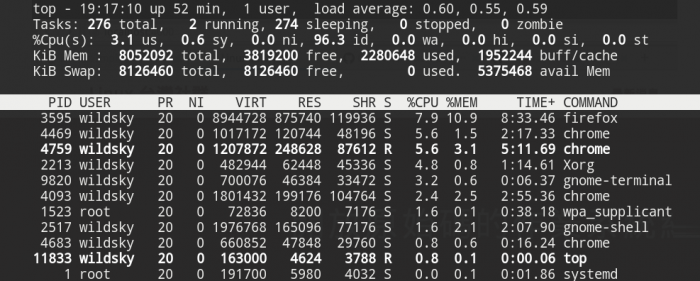本章節承接 Process(上),會繼續談到下列這些東西:
- process scheduling
- process scheduling queue
- Inter-process Communication
- Share Memory
- Message Passing
Process Scheduling 的概念
目的
- Multi-programming: 最大化 CPU 的產能(utilization)
- Time sharing: 因為程式是 輪流 去使用 CPU 的,所以誰先誰後就是 scheduler要處理的事情。
Process Scheduling Queue
- Job queue: 發生在 New State
- Ready queue: 發生在 Ready state,等著使用 CPU
- Device queue: 發生在 Wait State,等著使用 I/O

scheduler
scheduler 根據「即將被處理」的對象不同會有不同的 scheduler,像是 CPU scheduler、Job scheduler 之類的。
- short-term scheduler
- CPU scheduler 又被稱為 short-term scheduler,因為執行的頻率較高
- Ready State -> Run State
- long-term scheduler
- Job scheduler。相較於 CPU 的頻率來看,Job scheduler 的執行的頻率較低
- 有新的程式被執行,要產生 process 時才會執行的 scheduler。
- 主要是人的行為觸發。
- New State -> Ready State
- Medium-term scheduler
- 把 program 從 memory swap 回 disk 成 memory content(和之後會講到的 virtual memory 有關)
- Ready State -> Wait State
short-term scheduler
- 執行頻率很高(e.g., once per 100ms )
- 所以執行的效率就必須要很高
- 要想演算法來縮短每個 process 的等待時間(還要在意 fairness)
- 又因為效率要高,所以也不能太複雜(不然 CPU overhead 就會太高)
- overehad = (選的時間) / (執行 job 的時間 + 選的時間)
long-term scheduler
- 控制 degree of multi-programming
- degree of multi-programming 指的是「目前電腦上,有多少程式在 memory 中」
- 太低的話,CPU 就會有很大的時間在 idle
- 太高的話,就會發生 trashing。很多程式在搶 memory,會一直做 swap、不斷地做 I/O。
- 負責讓 CPU & I/O 有最高的產能:所以就要混著讓做 CPU & 做 I/O 的程式進來
medium-term scheduler
處理程式在 memory & disk 之間切換的 scheduler,現在電腦因為 memory 比較夠、且有 virtual memory 的概念,所以 long-term scheduler 比較式微,其工作相較過往,都會比較落在 medium-term scheduler 身上。
- swap out: 把 process 從 memory 搬回 disk 上來減少 degree of multi-programming
- swap in: 發現 memory 有空間了,就把 process 從 disk 抓回 memory
- propose:
- improve process mix:控制 CPU & I/O bound
- free up memory
Inter-process Communication (IPC)
- 定義:在一或多個 Process 或 Thread 之間,用來溝通的方法
- 種類
- 不溝通的:independent process
- 會溝通的:cooperating process
- 目的
- 資訊共享
- 加速運算(平行運算)
- 方便
- modularity(e.g. micro-kernel)
How-to IPC
要做到 IPC 有兩種方式:
- share memory
- user synchronization 要更小心謹慎(處理這個最痛苦啊)
- 好處就是快
- 透過 memory 的 address
- message passing
- 需要 system call,所以通常較慢
- 但若資料小,用這個方法的話可以省去 share memory 的 lock 之類的額外資源消耗,反而會略快(且不用在意 sync 的問題)
Share Memory
- 要知道怎麼 create 一個可以共用的 memory 區塊
- 預設是不會發生,因為 OS 要確保 process 的 protection
- 開空間要呼叫 system call
- 但資料格式都是一堆 bytes,由 process 自行定義、處理
- 必須確保不會同時有兩個對同一塊 memory 進行寫入的 access 行為
這邊周老師舉了個 consumer & producer 的例子,不使用 locking 的話會需要犧牲一塊空間來做到 synchronization。
Message Passing
好處
- 通常內含 synchronize 的機制,programmer 不用擔心這件事
- 可以自行掌控各個 variable,不用擔心被別人亂竄改
方式有兩種:
- Sockets
- network 中的 IP/port,IP 就是電腦,port 就是 process
- 資料格式就是 stream of bytes
- Remote Procedure Calls
- 使用遠端提供的 function call 去做到資料的傳輸
- 輸入輸出會有預先定義好的資料格式
一般來說,OS 會提供兩種 function 讓程式之間可以 Call,並在背後做各種 memory copy 的處理。
- send(Message)
- receive(Message)
而整個 communication system 還會需要提供一個 link,以便可以溝通,這個 Link 又會分為兩類:
-
Physical
- 是透過 network 還是 HW bus,甚至是 shared memory 等等的做法
-
Logical
- direct / indirect:要否指定接收對象
- 方向性:只能 A 傳 B,B 不能傳 A
- 角色是否相對
- Blocking / non-blocking:行為做完才會回傳 or not
- send by copy or by reference
- 固定大小 / 可變大小 的 message
Direct V.S Indirect Message Passing
Direct
- send & receive 的 params 中就需要有對方的 identity
- 可以不用 init
- 一定是 1 to 1
- modularity 有限
Indirect
- 會有一個 mailbox,要傳的人會把東西丟進去,要拿的人再跟 mailbox 拿
- sender & receiver 都不用在意對方是誰
- connection 需要由 programmer 建立
- 可以多對多
- 處理 message 的管理的人會是另一個程式,而非收送雙方,Mailbox 可以是 by OS 或 by process
- Issue: 可能會有個人同時跟 mailbox 拿資料,理論上一個 msg 應該只有一個人拿得到,所以下面就有幾個解法
- 只允許一個 receiver(最爛,根本就是 direct)
- 用 Locking 的方式,確保同一時間只有一個 receiver
- 交給 mailbox 決定,會分為兩步驟。receiver 會先要求要取值,而 mailbox 決定要給誰之後再去跟 receiver 說有沒有拿到。
Blocking V.S non-Blocking
- blocking -> synchronous
- non-blocking -> asynchronous
Blocking
non-Blocking
Send
確定對方接到後才會 return
送出後就不管
Receive
拿到 Message 才會 return
Call 完後就不管。
通常會拿到一個 token,
之後確認有拿到後
再用 callback function 去處理它
Buffer 與此兩種之間的關係
- Blocking 通常會有 size=1 的 buffer,用來 check 是否完成行為。(未完成就一個擋著)
- Non-blocking 則有兩種情況
- bounded: 送到滿了之後就會 blocking,或是 throw 一個 error
- unbounded: 不管,就是送到整個 OS 都滿了才會不給送
Socket
- 會有 client & server
- server 要先打開 client 才能連
- client 進行 connect 之後,就可以盡情 read / write
- 補充:
- server 在 accept 之後,會動態開 thread,如此才能一次處理多個 request
Remote Procedure Calls (RPC)
-
Library 通常會有 stubs,在 client 端和 server 端會各有一隻小程式,(server 端的叫 skeleton)會負責 implement 細節
-
其實通常下面也可能用 socket,只是幫 programmer 包起來而已
-
parameter mashaling
- 把 params 包進 message 就叫
- 要把兩台電腦串在一起其實有許多細節要處理,RPC 就要負責幫使用者把這些繁瑣的事情解決掉
